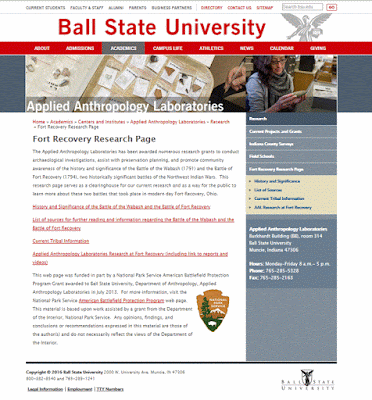"The Applied Anthropology Laboratories has been awarded numerous research grants to conduct archaeological investigations, assist with preservation planning, and promote community awareness of the history and significance of the Battle of the Wabash (1791) and the Battle of Fort Recovery (1794), two historically significant battles of the Northwest Indian Wars. This research page serves as a clearinghouse for our current research and as a way for the public to learn more about these two battles that took place in modern day Fort Recovery, Ohio."
History and Significance of the
Battle of the Wabash and the Battle of Fort Recovery
List of Sources
"Many of these resources are on-line or readily available. Click on a topic... for an associated bibliography and links when available."
- American Revolution Era
- Anthony Wayne
- Arthur St. Clair
- Battle of Fallen Timbers 1794
- Battle of Fort Recovery 1794
- Battle of the Wabash 1791
- Battlefield and Contemporary Artifacts
- Diaries from the Battle of Fort Recovery
- Diaries from the Battle of the Wabash
- Fort Jefferson
- Guns and Armament
- Late 18th and Early 19th Century U.S. Military
- Maps
- Mishikinakwa (Little Turtle)
- Native American Alliance
- Native American Battlefield Tactics
- Weyapiersenwah (Blue Jacket)
Current Tribal Information
"At the Battle of the Wabash in 1791, St. Clair and his American army were confronted by a large alliance of Native Americans, led by Weyapiersenwa (Blue Jacket of the Shawnee) and Mishikinakwa (Little Turtle of the Miami). This force was comprised of seasoned, volunteer warriors from nine different Native American tribes and from other smaller Native American groups. The major tribes in the Battle of the Wabash were the Wyandots, Mingo, Cherokee, Ojibwe, Ottawa, Potawatomi, Shawnee, Delaware, and Miami. Together these nine tribes accounted for the estimated 1,400 warriors on the day of battle.
The Native American alliance was ultimately able to surround, attack, and defeat the American force led by St. Clair in less than three hours..... "
- Absentee Shawnee Tribe
- Bad River Band of the Lake Superior Chippewa Tribe
- Bois Forte Band of Chippewa
- Cherokee Nation
- Citizen Potawatomi Nation
- The Delaware Nation
- Delaware Tribe of Indians
- Eastern Band of Cherokee
- Eastern Shawnee Tribe of Oklahoma
- Fond du Lac Band of Lake Superior Chippewa
- Forest County Potawatomi
- Grand Portage Chippewa Band
- The Grand Traverse Band Ottawa and Chippewa Indians
- Gun Lake Tribe (Match-e-be-nash-she-wish) Band of Pottawatomi Indians
- Lac Courte Oreilles Band of Lake Superior Chippewa Indians
- Lac du Flambeau Band of Lake Superior Chippewa Indians
- Lac Vieux Desert Band of Lake Superior Chippewa Indians
- Leech Lake Band of Ojibwe
- Little River Band of Ottawa Indians
- The Miami Tribe of Oklahoma
- Mille Lake Band of Ojibwe
- Minnesota Chippewa Tribe
- Nottawaseppi Huron Band of the Potawatomi
- Ottawa Tribe of Oklahoma
- Pokagon Band of Potawatomi
- Prairie Band Potawatomi Nation
- Red Cliff Band of Lake Superior Chippewa
- Red Lake Nation
- Saginaw Chippewa Indian Tribe
- Sault Ste. Marie Tribe of Chippewa Indians
- The Shawnee Tribe
- St. Croix Chippewa Indians of Wisconsin
- Turtle Mountain Band of Chippewa Indians
- United Keetoowah Band of Cherokee Indians in Oklahoma
- White Earth Nation
- Wyandotte Nation
- The Battles of Fort Recovery: Archaeology and Site Identification
- Fort Recovery Documentary and Public Archaeology Volume
- Battle of the Wabash 1791: Native American Battle Strategies
- The Battles of Fort Recovery: National Register Nomination
- The Battle of the Wabash and the Battle of Fort Recovery
- The Battles of Fort Recovery: Preservation Planning
- The Battles of Fort Recovery: Additional Archaeology
- Battles of the Wabash and Fort Recovery: Sign Development and Design
- The Battles of Fort Recovery: Wayside Exhibits Planning and Design

No comments:
Post a Comment